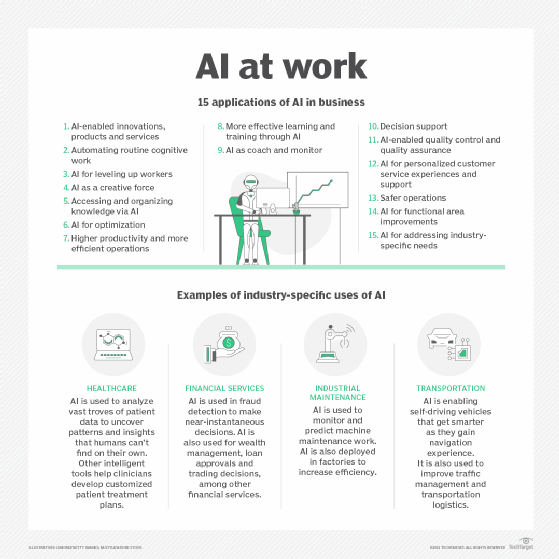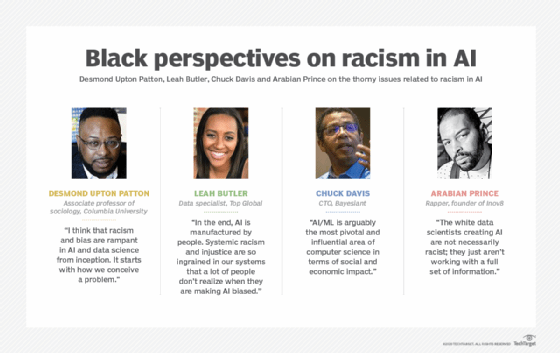
Getty Images/iStockphoto
The impact of AI on social media
The newfound potential of AI -- especially with the recent explosion of generative AI models -- is affecting how humans interact and publish media online.
AI is making waves in how it could change the way humans interact and consume content online.
The most recent uses for AI include art, text and artificial voice generation. But it is already used in a number of applications, such as content personalization, healthcare, navigation and facial recognition systems.
AI has also changed the social landscape through its use in social media. AI can be beneficial to general users, marketers and the platform itself. But it also comes with some challenges.
Applications and examples of AI use in social media
Social media uses AI to increase personalization and efficiency while delivering relevant content to users. Key applications of AI use in social media include the following:
- Advertising management. AI-enabled tools help in advertising management and optimization. These tools can typically analyze and target ad variations, as well as perform customer segmentation.
- Analyzing, sorting and tagging data. AI-based tools collect, analyze and tag large amounts of user-generated data for both advertising and moderation purposes.
- Automatic posting and scheduling. AI tools can integrate with social media platforms to schedule and post content at specified times or when they'd receive the most engagement.
- Content generation. Generative AI can be used to create social media posts with text or images or to create hashtags for a described post for an account.
- Influencer marketing. AI-enabled tools determine who the best influencer is to advertise a specific ad campaign. Different influencers have different audience target demographics with varying reach.
- Content moderation. AI-enabled bots scrape data to find and filter out spam, guideline-breaking or inappropriate content. AI tools can also ban accounts that post that content.
- Content recommendations. AI tools can recommend video, text or image content that users may like based on previously consumed content.
- Video filtering. AI in facial recognition software helps recognize facial structures to identify users or overly edited filters on the user.
For example, Snapchat uses video filters to create effects on a user's face. Snapchat also released a generative AI chatbot powered by ChatGPT's technology called My AI. Users can chat with My AI for recommendations, to answer questions or to complete other tasks similar to ChatGPT.
Other social media platforms, such as Twitter, Facebook, Instagram and LinkedIn, use AI for content moderation. These platforms also use AI in other areas, such as Instagram, which enables users to create and share stickers.
Twitter, for example, uses an AI tool to determine what content to recommend for a user's timeline. Twitter also uses IBM Watson and natural language processing tools to moderate offensive posts.
As another example, Instagram uses AI to filter spam and uses deep analytics for text to detect and delete posts with hate speech or that promote cyberbullying. Instagram also uses AI tools to target advertising to users.
LinkedIn uses AI to help hiring teams write job descriptions.

Benefits of AI in social media
AI is already being used in many systems, but the popularity of generative AI tools, such as Dall-E, ChatGPT and Google Bard, has prompted widespread conversations on its use and continued development.
The benefits of AI in social media include the following:
- Creating a more welcoming social media landscape to identify hateful or inappropriate content.
- Gathering customer sentiments to find positive and negative comments or posts.
- Showing specific advertisements to users most likely to engage with a brand based on user data.
- Showing users content they might like based on posts, accounts or likes with the goal of further personalizing content and improving the user experience.
Risks of AI in social media
AI also carries its share of risks. One major concern is AI bias, where systemically prejudiced decisions are made due to assumptions created in the machine learning process. Lack of quality, objectivity and a large enough size of training data all contribute to AI bias. Likewise, biased humans may also inadvertently create biased algorithms.

Another concern is promoting echo chambers, where thousands of users with one opinion continue to share and reinforce a specific viewpoint or belief. By recommending content that users express interest in, social media platforms could expose users to questionable content, such as posts that spread disinformation. This can reinforce biased beliefs in users.
Some AI tools may also collect data on users that others may find intrusive. For example, social media platforms may collect data on a user's age, name, location, online activity and photo metatags for the purpose of creating a more targeted advertising experience.
Due to the amount of content posted on platforms such as TikTok and YouTube, AI algorithms are commonly used to moderate content. However, this can lead to improper takedowns and inappropriate content that slips through the cracks. For example, YouTube's use of AI content moderation once led to many incorrect video takedowns that creators appealed after the fact.
There is also concern about the spreading of deepfakes on social media for malicious social and political use. A malicious actor could spread falsely generated images or videos of someone else for political or monetary gain.
How AI in social media affects audiences
AI in social media affects end users, marketers and social media companies.
Social media companies use AI tools to do the following:
- Moderate content.
- Recommend content.
- Sort through large data sets.
- Target advertising.
Typically, AI employed by social media companies surrounds tools built into the platform that focus on simplifying processes such as handling large amounts of data or targeting ads based on user preferences.
Marketers use AI tools with social media for the following:
- Content scheduling.
- Audience segment creation.
- Influencer marketing.
- Logo detection to monitor advertising campaigns.
- Advertising management.
- Social listening.
AI tools that marketers use include either advertising tools built into the platform or third-party tools that integrate with the platform to provide additional functionality, such as sentiment or competitor analysis.
Social media end users typically interact with AI in scenarios such as the following:
- Content scheduling and autoposting.
- Hashtag generation.
- Text or video content generation.
- Platform-integrated AI chatbots.
- Video filters.
Social media end users interact with AI tools that are built into the social media platform. These interactions can include using video filters to change the user's appearance or interacting with an AI chatbot to answer questions. End users can also use third-party applications to schedule posts or to generate content for posting.







